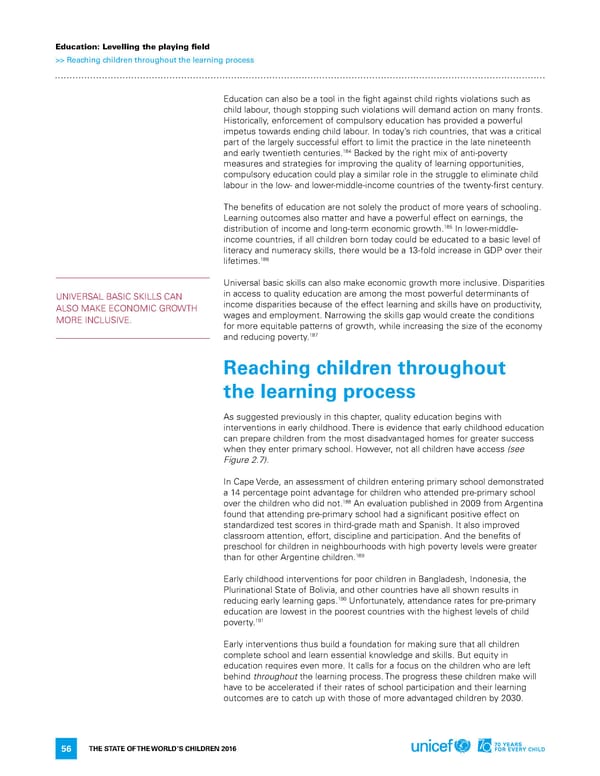Education: Levelling the playing field >> Reaching children throughout the learning process education can also be a tool in the fight against child rights violations such as child labour, though stopping such violations will demand action on many fronts. historically, enforcement of compulsory education has provided a powerful impetus towards ending child labour. in today’s rich countries, that was a critical part of the largely successful effort to limit the practice in the late nineteenth 184 and early twentieth centuries. Backed by the right mix of anti-poverty measures and strategies for improving the quality of learning opportunities, compulsory education could play a similar role in the struggle to eliminate child labour in the low- and lower-middle-income countries of the twenty-first century. The benefits of education are not solely the product of more years of schooling. learning outcomes also matter and have a powerful effect on earnings, the 185 distribution of income and long-term economic growth. in lower-middle- income countries, if all children born today could be educated to a basic level of literacy and numeracy skills, there would be a 13-fold increase in GdP over their 186 lifetimes. Universal basic skills can also make economic growth more inclusive. disparities UniVerSal BaSiC SKillS Can in access to quality education are among the most powerful determinants of alSo MaKe eConoMiC GroWTh income disparities because of the effect learning and skills have on productivity, More inClUSiVe. wages and employment. narrowing the skills gap would create the conditions for more equitable patterns of growth, while increasing the size of the economy 187 and reducing poverty. Reaching children throughout the learning process as suggested previously in this chapter, quality education begins with interventions in early childhood. There is evidence that early childhood education can prepare children from the most disadvantaged homes for greater success when they enter primary school. however, not all children have access (see Figure 2.7). in Cape Verde, an assessment of children entering primary school demonstrated a 14 percentage point advantage for children who attended pre-primary school 188 over the children who did not. an evaluation published in 2009 from argentina found that attending pre-primary school had a significant positive effect on standardized test scores in third-grade math and Spanish. it also improved classroom attention, effort, discipline and participation. and the benefits of preschool for children in neighbourhoods with high poverty levels were greater 189 than for other argentine children. early childhood interventions for poor children in Bangladesh, indonesia, the Plurinational State of Bolivia, and other countries have all shown results in reducing early learning gaps.190 Unfortunately, attendance rates for pre-primary education are lowest in the poorest countries with the highest levels of child poverty.191 early interventions thus build a foundation for making sure that all children complete school and learn essential knowledge and skills. But equity in education requires even more. it calls for a focus on the children who are left behind throughout the learning process. The progress these children make will have to be accelerated if their rates of school participation and their learning outcomes are to catch up with those of more advantaged children by 2030. The STaTe of The World’S Children 2016 56
 70 Years for Every Child Page 71 Page 73
70 Years for Every Child Page 71 Page 73